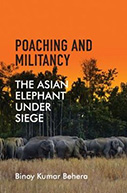Poaching And Militancy: The Asian Elephant Under Siege

Author: Binoy Kumar Behera
Publisher: Cambridge, UK; New York: Cambridge University Press 2018. 156p.
Reviewer: Jessica Bell Rizzolo | July 2019
Poaching and Militancy: The Asian Elephant under Siege provides an intriguing and unique examination of the problem of elephant deaths in Odisha, India. The author’s examination of this topic is far from insular. He successfully examines this disturbing trend within the larger contexts of human-elephant conflict, wildlife poaching, evolutionary biology, and armed conflict. A particular strength of this text is the author’s personal experience; he served as a senior police and government officer for multiple decades, and his first-hand observations are well-integrated with additional sources of quantitative and qualitative data.
Part 1 traces the evolutionary history of the Indian Asian elephant (Elephas maximus indicus), the similarities and differences between Asian and African elephants, the challenges that the Anthropocene poses for elephant survival, and the methodological underpinnings of the work. An important point, returned to numerous times throughout the text, is that, for Asian elephants (unlike African elephants), only the males possess tusks and are thus disproportionately killed. Throughout the work, the author examines how elephant biology reciprocally interacts with the social context of poaching.
Part 2 critically examines the concept of human-elephant conflict (HEC). The author draws upon animal behavior, animal psychology, and detailed observational data to examine patterns of human-elephant interaction, situating elephant deaths within this larger issue. This section provides an important contribution to the literature on HEC by providing a nuanced examination of both the social costs of elephant crop raiding and house breakage, as well as an illustration of how human retaliatory aggression towards elephants can exacerbate the problem.
Part 3 traces the patterns of elephant killing in Odisha, India over the course of numerous years, and discusses four causes of elephant deaths: poaching, accidental deaths, natural causes, and unknown reasons. The author’s analysis of his data (governmental tallies) is thoughtful; he considers the difficulty in obtaining accurate tallies and notes how armed conflict can interfere with the gathering of data. This section also provides an interesting overview of how poaching methods influence both data collection and wildlife crime prosecution. For example, the author traces how poachers have shifted to indirect methods of killing (such as electrocution), which poses a problem both for the identification of perpetrators and for the survival of Asian elephants (unlike directed killing, these methods are beginning to impact females and juveniles).
The final sections of the text look at the potential collusion between wildlife poachers and militants in India, and offer suggestions for effectively addressing the risks to Asian elephants. The author uses geographic data to examine the overlap of hotspots of poaching and of armed conflict. Although this provides some insights worthy of additional consideration, it remains circumstantial. The author himself stops short of arguing that the overlap of poaching and militant activity is causal. Unfortunately, he provides limited information on the Naxalite conflict (the primary conflict mentioned in the text), and the reader is left to wonder how and why this conflict emerged. Further, he could have more critically interrogated the label of “militant’ to examine how the state’s interests affect who is viewed as a terroristic actor. Despite these limitations, the volume makes a convincing case that the Asian elephant is in crisis and that further collaboration (such as data sharing and enforcement) between security and conservation agencies would help protect this species. For example, the author traces the resultant damage to wildlife when wildlife authorities decided to exclude police officers from entering their parks. Overall, the book provides a nuanced examination of elephant deaths and human-elephant conflict that effectively triangulates observational data, quantitative statistics, and the unique perspective of an anti-poaching officer. Even if the links between poaching and militancy remain tenuous, this work convincingly outlines how a sharp division between security and conservation enforcement can have unintended and detrimental consequences.
Jessica Bell Rizzolo, Department of Sociology, Environmental Science & Policy Program, Michigan State University


